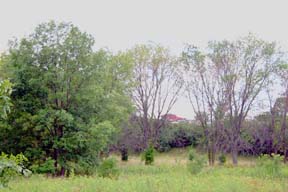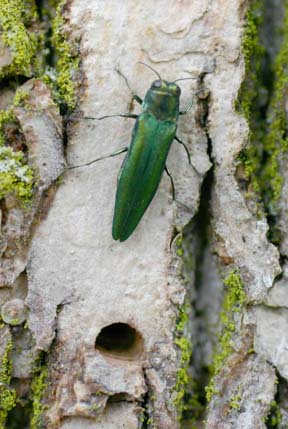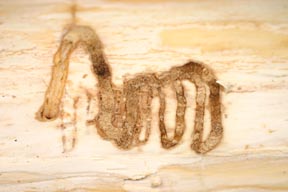Emerald Ash Borer | |
|---|---|
| July 17, 2007 | |
Emerald Ash Borer, Agrilus planipennis, is an exotic, invasive insect in North America that attacks and kills healthy ash trees. All ashes in the genus Fraxinus are attacked, including green, white, blue, and black ash. Its native range includes China, Korea, Japan, Mongolia, the Russian Far East, and Taiwan. It was first identified in the Detroit, Michigan, area in July 2002. Since then, it has also been found in other areas of Michigan, as well as Illinois, Indiana, Ohio, other locations outside the Midwest, including the Toronto, Ontario, area in Canada. Ash trees are important in our residential landscapes, towns, cities, and forests in Illinois. In many communities, ash trees comprise 10 to 20 percent of the trees. EAB-infested ash trees. Adult beetles are 1/3 to 1/2 inch long and elongate, with metallic emerald green wing covers on a bronze body. The upper surface of the abdomen is bright red, which is only obvious when they fly. They emerge primarily in late spring through 1/8-inch-wide, D-shaped holes in the bark of ashes. Adult beetles are present through June into mid-July. After mating, the female inserts her eggs, one or two at a time, between bark flakes.  The eggs hatch into larvae that tunnel through the bark into the cambium, where the water-, nutrient-, and sugar-conducting tissues, the xylem and phloem, are located. The larvae are white, elongate, and flattened, growing to about 1-1/2 inches long. The larval body appears as flattened beads, and there are two short, dark brown to black spinelike cerci at the posterior end of the body. After feeding for one or two growing seasons, the larvae tunnel as much as 1/2 inch into the sapwood below the cambium to pupate. Adult beetles emerge the following spring.  The larvae create slender, winding tunnels that frequently wind back and forth, creating a series of S-shapes that run into one another. Just as commonly, the tunnels meander under the bark with no particular pattern. As the tunnels become numerous, they effectively girdle the branch, causing the branch to die due to lack of water and nutrients. Emerald ash borer attacks at the top of the tree first, causing dieback of the top. Attack continues down the tree, resulting in the gradual death of branches, and the entire tree eventually dies. Larvae commonly attack the tree for 2 years or more before branch dieback becomes evident. Once dieback starts to occur, the tree usually dies in 2 to 3 years. The bark on attacked trees separates from the tree trunk, allowing the larval tunnels to be easily seen. Once the tree dies to the ground, suckers form around the base of the trunk, but they do not grow into strong, attractive trees. These suckers are also attacked and killed by the emerald ash borer. Woodpeckers attack the larvae under the bark, chipping away the bark to reach the larvae. This attack appears as light areas on the bark and is a useful means of identifying potentially attacked trees before dieback becomes evident. The only sure method of detecting emerald ash borer in a recently attacked tree is to remove the tree or some of its branches and strip the bark off to reveal the larval tunnels. Upper branches are most likely to be infested. In practice, a drawknife is typically used to remove the bark, while a pocketknife is used to get the larvae out of the tunnels for identification. The only sure method to control emerald ash borer is to remove the tree. Imidacloprid (Merit, Imicide, IMA-jet, Pointer) has been shown to control the emerald ash borer enough to prevent tree death for at least a few years. Merit is typically applied as a soil-injected or surface soil application within 2 feet of the trunk. Imicide, IMA-jet, and Pointer are injected into the basal flare or trunk of the tree. Dinotefuran (Safari) applied along with PentraBark to the outside bark surface of the tree is also effective. Applications should be made annually and are most effective after at least 2 years of application. Application is recommended to trees within 15 miles of a known infestation, to allow for undetected infested trees and at least 2 years of application before attack. Even some previously attacked trees exhibiting dieback survive and show signs of recovery in the form of normal stem and leaf growth. Foliar and bark sprays of bifenthrin (Onyx), cyfluthrin (Tempo), permethrin (Astro), or carbaryl (Sevin) applied monthly from mid-May to mid-July control visiting beetles and hatching larvae. Because emerald ash borers may emerge in smaller numbers later in the season, applications against adults are primarily effective in reducing the spread of the insect rather than protecting attacked trees. The applications of imidacloprid or dinotefuran, which move systemically through the tree, are more likely to provide useful control. �� | |
| Author: | Phil Nixon |
